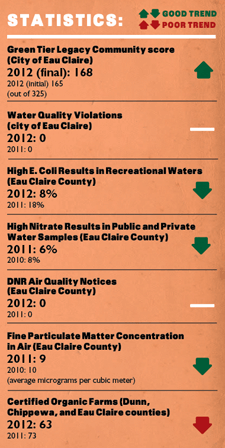Environment
|
Short of a big toxic spill or another major catastrophe, quantifiable measures of environmental quality usually depends on what isn’t there rather than what is. In that respect, the Chippewa Valley seems to be doing well: There were no Department of Natural Resources air quality notices for Eau Claire County last year (the DNR issues warnings when ozone and particle pollution are high), and the average amount of fine particle pollution in the air declined from 2010 to 2011 (the most recent year for which statistics were available). The water’s clean, too: Eau Claire’s municipal water was found to be free of unsafe levels of the more than 100 contaminants the DNR tests for, and this summer the Eau Claire municipal well field will officially be removed from the National Priorities List of hazardous waste sites (don’t worry, decades-old contamination from the nearby National Presto Industries site was deemed to be remediated back in the 1990s). “Eau Claire gets an ‘A’ for the high air quality and living up to the ‘clear water’ reputation in terms of water quality,” says Tom Stolp, an Eau Claire native and field director for the Wisconsin League of Conservation Voters. “However, the real gem of our local environment has to be the abundant opportunities to recreate outdoors.” “Eau Claire gets an ‘A’ for the high air quality and living up to the ‘clear water’ reputation.” Last year, Eau Claire became one of the first cities in the state to sign up as a Green Tier Legacy Community. This designation means the city will work toward a series of sustainability goals in areas ranging from zoning to energy use. The city began with a baseline score of 165 out of a possible 325 points, which by the end of 2012 had risen to 168. Meanwhile, according to the National Citizen Survey conducted in 2012, 84 percent of city residents rate the quality of the natural environment as “excellent” or “good,” which is “much above” the national benchmark. Of course, none of this means environmental concerns have taken a back burner. On the contrary, local environmentalists are alarmed about the short- and long-term impacts the region’s booming frac sand mining industry will have on the environment, particularly because of increased fine particulate matter in the air and the potential impacts on water quality and quantity. The proposed open-pit iron ore mine in Ashland and Iron counties also worries conservation groups. |
The Valley has a relatively clean record, and we should keep working hard to keep our air, water, and soil that way because natural resources are key to other areas, including health, the economy, and tourism. The future impact of frac sand mining is uncertain, leaving the region with an incomplete grade in that area. |
Listen! Editor's Conference
![]()
Tom Stolp, field director, Wisconsin League of Conservation Voters; Jane Schley, executive committee, Sierra Club-John Muir Chapter; U.S. Environmental Protection Agency; City of Eau Claire; Wisconsin Department of Natural Resources; Eau Claire City-County Health Department; Wisconsin Department of Agriculture, Trade, and Consumer Protection.




